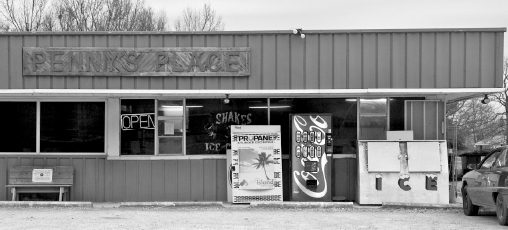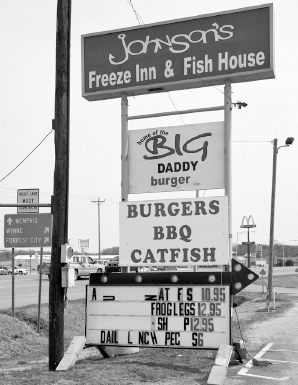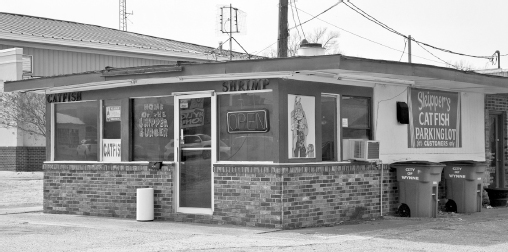
7
THE LONG ROADS
U.S. Highway 49, Arkansas Highway 1 and Crowley’s Ridge Parkway
U.S. HIGHWAY 49
U.S. Highway 49 gets its fame from that incident where bluesman Robert Johnson allegedly sold his soul to the Devil at its intersection with U.S. Highway 61 in Mississippi. In Arkansas, it cuts a crescent through the Delta, entering at Helena–West Helena and curling west and then northeast to bisect Brinkley and Jonesboro before reaching its northern terminus at Piggott.
Unlike most of the other federal highways through Arkansas that were formed when the system first came online in 1926, most of U.S. Highway 49 through Arkansas wasn’t built until the 1960s. It was first extended from Clarksville, Mississippi, to Brinkley in 1963 (replacing Arkansas Highway 6), farther north to Jonesboro in 1978 (replacing Arkansas Highway 39) and finally to Piggott via concurrency with Arkansas Highway 1. From Brinkley north, it runs parallel to the St. Louis Southwestern rail line, better known as the Cotton Belt Route.
Crowley’s Ridge Parkway came later. It was first designated an Arkansas Scenic Byway in 1997 before becoming a National Scenic Byway in 2000 with the addition of a fourteen-mile stretch in Missouri. At its southern end, it runs concurrent with U.S. Highway 49 before splitting north of Helena–West Helena to crawl on a narrow two-lane road through the Saint Francis National Forest up to Marianna. There, it splits off the Great River Road and heads north along Arkansas Highway 1. The designation skips back and forth between highway and county roads, always running alongside or atop Crowley’s Ridge, passing through cities and the largest Arkansas state park, Village Creek State Park.
Crowley’s Ridge itself is a geological oddity. Situated in the middle of the Mississippi River Alluvial Plain in Arkansas, it rises from 200 to 550 feet in elevation along the Mississippi Embayment for around 150 miles, mostly in Arkansas. Benjamin Crowley gave it his name. He was the first settler known to have built a home there, back in 1820. It’s made of loess (pronounced “luss”)—mostly windborne sediment, quite different from the black, rich soil of the Delta.
Communities dot the two lines across the central and northern sections of the Arkansas Delta. Among them are some of the Delta’s more definitive restaurants.
PENNY’S PLACE, WEINER
In the summer of 1996, I discovered Lake Hogue. I left work at nine o’clock each morning and found it impossible to sleep during the day, so in summer I would go fishing, sometimes by myself, sometimes with my boyfriend. It wasn’t far from Jonesboro and sitting on the dam or slinging a line into the lake or Bayou De View right next to it was sure to net some catfish, crappie or sunfish (and one night, a very irritated and large gar).
When we tired of making the attempt, a stop at J&D’s Dairy Bar in Weiner was in order. Jackie and Darrel Bryant—the J and D in the name—built the little dairy bar across from a rice gin in 1972. Jackie would invariably be around, and the burgers and dipped cones were always perfect after a sweaty, stinky morning of fishing. She never complained about our appearance, despite the fact that she kept the place neat as a pin.

Penny’s Place in Weiner. Grav Weldon.
The Bryants ran the place until 2004, when it was purchased by Penny Sitzer. Very little has changed, besides the name and a few additions to the menu. I made my first return visit back to the little dairy bar in the summer of 2010 while working on a breakfast cover story for the Arkansas Times. I left Little Rock at four o’clock in the morning, and at six o’clock, I arrived to find the place packed with locals. I found a single spot to perch and immediately had Sitzer’s attention. She brought me a coffee cup before I could even ask and gave me every bit of attention everyone else in the duck blind-inspired interior was getting. The coffee was hot, and Sitzer managed to steal my heart with homemade biscuits and cream gravy.
“I bought it because I just love to cook and feed people a good home cooked meal,” Sitzer shared with me in a Facebook message. “This year I’ve added a barbecue shed to cook ribs, butts and burgers all off the grill.”
You could smell it, too, when we went by on our research trip in March 2013. While breakfast was being served, the scent of rubbed butts smoking in the shed drew more people in off U.S. Highway 49, almost like magic. She’s also added frog legs, hand-battered chicken-fried steaks and barbecue burgers, which she sauces and smokes, that taste just like what you’d get at a backyard get-together. Sitzer’s also taken to making cinnamon rolls. Every bit of the new menu seems to be winning more return customers.

Josie’s is a famed steakhouse—we’ll get into its history on page 188. Attached under the same roof, you’ll find the Dairy Shack, or D-Shack, which has been around since rocks were soft. D-Shack’s burgers are flat and juicy, and you have to tell the cook what you want on them, since there’s no default choice for condiments or such. There’s a daily lunch special for $4.99, a meat-and-two-veg special that features things like a chopped steak, fried chicken or chopped pork barbecue, locally farm raised catfish, tilapia and shrimp. Barbecue sandwiches start at $1.90, and there are nine different flavors of milkshake—including peanut butter, pineapple, butterscotch and cherry. Grav Weldon.
If you are lucky, and I mean very lucky, you might chance on Penny’s Place when the chocolate rolls are just coming out. Similar to cinnamon rolls, these cocoa-infused swirls are legendary.
WOODY’S BAR-B-Q, WALDENBURG
William Wood never intended to get into the barbecue business. He was a cropduster pilot and spent many seasons over the fields of the north Delta. Starting in 1985, during the spring and fall, Woody and his wife, Cecelia, set up their RV at the four-way stop where U.S. Highway 49 meets Arkansas Highway 14, selling barbecue to passersby to earn a little money they could go fishing on.
Thing is, Woody had himself some good barbecue, and it got popular.
“We never actually intended on doing what we done,” he told me. “We got to coming over to this four-way stop in Waldenburg, and we had a motor home and we’d sit at the four-way stop, selling barbecue for fun. It finally got out of hand and got big enough in 1992, I finally just had to crawl out of the airplane and do barbecue full time.”
Woody and Cecelia’s operation took off. Today, the scent of roasting meat could pull you right off the highway. No beef here—Woody only smokes pork and chicken.
The smoke’s good, but it’s the sauce that made Woody’s famous. “We started doing a lot of catering, and we came up with this barbecue sauce,” he continued. “Everybody kept wanting to buy it. We would make it in our carport on a fish cooker in a three-gallon pot.
“One day, someone came by and asked for just a cup of sauce and we sold it to him. We figured if people would buy just the sauce, we needed to sell that sauce. Took us two years to sell that first bottle. We sold that first bottle in 1996, and we come up with the dry rub barbecue seasoning in 1999. Now we’re shipping it all over the country. We built a four-thousand-square-foot facility where we make and package our own products, and we pack for other people.”
I asked him if he’d go back to cropdusting if he could.
“Not really, no. The rules and regulations have gotten to be so much. I miss the old airplanes a little bit but the other part of it, no, I wouldn’t want to get back in there.”
Twenty years of cropdusting and another thirty years of barbecue have made it a long stretch for Woody and Cecelia. They’re hoping someone might eventually come through and buy out the operation and keep on making Woody’s Bar-B-Q sauce and seasoning. Their three children all have jobs of their own and no interest in taking it on. For now, they’re still hanging out at the four-way stop whenever the weather’s right every Wednesday, Thursday and Friday night.
Here’s a secret: you can make a killer barbecue party dip out of Woody’s dry rub. The recipe:
Woody’s Bar-B-Q Dip
8 ounces sour cream
2 tablespoons Miracle Whip salad dressing
2 tablespoons Woody’s Dry Rub
Blend all ingredients together and refrigerate. Stays good up to three weeks, but it usually won’t last that long. Serve with crackers or chips.
WYNNE
The city of Wynne began in 1882 when a train on the St. Louis, Iron Mountain and Southern Railroad derailed. One of the boxcars was uprighted and named Wynne Station in honor of Captain Jesse Wynne of Forrest City, who, surprisingly enough from this book’s perspective, was not a railroad worker or magnate but a banker who had established the Bank of Eastern Arkansas.
Peebles Farm, located between McCrory and Augusta on U.S. Highway 64, has become famous for its annual corn maze. Each year, the folks that run this pick-your-own farm come up with a new design for the maze, which often includes designs that can be spotted from overhead. Previous year’s designs include tractors, a riverboat, a barn, a duck, a spider’s web and even the county courthouse. It also offers pick-your-own cotton. Learn more at peeblesfarm.com.
More rails and trains were to come, and in 1885 the burg became the hub for construction of a line that would run from Memphis to Bald Knob (a route now traced by U.S. Highway 64). Full of rail workers, Wynne became a true Western town with five saloons, two hotels, a blacksmith, grocery and general stores and all the trappings of a pop-up city for folks who had money in pocket—and that was just in two years! Then, a fire on September 2, 1887, burned a lot of the new businesses.
Wynne didn’t quit. Almost everything was rebuilt. The next year Lon D. Freeman established the Wynne Ripsaw, which would be renamed the Wynne Progress in 1904. The east–west line started operation in 1888, and the town was incorporated. To this day, no one knows why it was named for Captain Wynne, but the name stuck. In 1907, a bottling plant opened there, eventually producing Nehi and Royal Crown Cola in 1940.
There’s no doubting that a town created by folks who worked on the railroad was made up of real characters. Back in the 1930s, H.K. Barwick owned the town’s automotive dealership. His brother, Chip, owned a similar operation in Memphis. H.K. reportedly had his brother and some other folks out duck hunting and came up with a crazy idea—take their live decoys (yes, live ducks, which were legal back then) and place them in the fountain inside the most regal hotel in all of Memphis. Which they then did. Today, you can watch the Peabody Ducks in their fountain in the lobby of the Peabody Hotel, though, these ducks are definitely not decoys.
KELLEY’S RESTAURANT, WYNNE
U.S. Highway 64’s path includes a large section of the Trail of Tears. It roughly parallels U.S. Highway 70 to the north. A corridor between the roads is home to Interstate 40 and to a portion of the Big Woods, which includes wetlands of the Cache, White and Arkansas River and Bayou De View.
Coming into Wynne heading east on U.S. Highway 64, you’ll encounter a large restaurant that’s been around since the 1950s, the last remnant of a dining giant that once spread throughout northeast Arkansas. The restaurant traces its lineage back to the proprietor of a little “cracker box” called the Night Hawk in Batesville. Jeff Kelley was good at running the restaurant and opened more—some around Batesville and some in other cities, including Newport, Pocahontas, Bald Knob and Wynne. He set up each of his four kids with those out-of-city restaurants, and they all thrived.
Batesville’s Kelley-Wyatt’s Restaurant and Bald Knob’s Kelley’s Restaurant managed to stay in business until 2013, but the other locations all withered away earlier, with the exception of the lone restaurant in Wynne. That’s a shame, since Jeff Kelley’s smorgasbord was one of the first buffets in the state.
In Wynne, Kelley’s is run by Jeff’s grandson, Shannon Kelley. It offers a seafood buffet on Friday nights and banquet-style meals any time. There’s always pie in the case, and chances are, if you go on a Saturday, you’ll probably notice someone’s wedding party come through.
JOHNSON’S FREEZE INN & FISH HOUSE, WYNNE
At U.S. Highway 64 and Arkansas Highway 1 in Wynne, there’s a flat sprawl of a restaurant that’s a little bit of everything. It appears to be a big restaurant on one side, a small dairy drive-thru on the other, and its lineage is all over the place. This is Johnson’s, though whether you want to call it Johnson’s Freeze Inn or Johnson’s Fish House or Johnson’s Diner is up to you. It’s both one restaurant and two, and there’s even, at one time, been a third. Confused yet?

Johnson’s Freeze Inn & Fish House still has two phone numbers—one for hamburgers and one for the diner. Grav Weldon.
Back in 1970, it was Chuck’s Bar-B-Q, and Carolyn Johnson went to work there. When the folks that were running it wanted to get out of the business, they offered it to Carolyn and her husband, W.C. Johnson. The deal stuck, and Chuck’s became Big Johnson’s. For thirty-five years, it was a marvelously fine place to get pork butt barbecue.
But in 2008, fire burned the restaurant. Carolyn Johnson was severely injured. While she recuperated, her daughter kept the business going in a food truck they dubbed Little Johnson’s.
The restaurant was rebuilt, and it’s now Johnson’s Fish House, at least on one side. On the other side, it’s Johnson’s Freeze Inn, a dairy drive-in where you can get burgers. The restaurant also serves catfish and old family barbecue, too. It’s one restaurant that’s part diner, part drive-in and all pretty good eats.
ARKANSAS HIGHWAY 1
Johnson’s isn’t the only place to pick up a burger. Six blocks away, you’ll find Skipper’s Catfish and Hamburger Delight. It’s in a little low-slung red building along the side of Arkansas Highway 1. The burgers are pretty decent, and the catfish is pretty satisfying.
The best burgers, in my opinion, come from Colby’s Café and Catering. The large restaurant on the flat plain south of town does a little bit of everything—pasta, southern food and sandwiches. Colby’s staff makes their own bread and some of the most amazing fried green tomatoes you can find anywhere.
Catty-corner across the street from Johnson’s stands Hickory House BBQ. Located in an old dairy diner, Rick James’s restaurant puts out simple barbecue low on the grease and high on the coleslaw. It’s been open since 1991.

Skipper’s Catfish and Hamburger Delight in Wynne. Grav Weldon.
Heading south toward Forrest City, you’ll eventually get to Mike’s Family Restaurant. You’ll know it from its green roof and the rocking chairs out front. Mike Linam originally planned, way back in 1993, to just have a store along Arkansas Highway 1. His little grocery store had a snackbar in it with hot things to eat. He worked with his wife and daughter and learned quickly how popular the snackbar was. It progressed over the years, and it wasn’t long before he closed half the grocery store and expanded the snackbar into a restaurant. Eventually the restaurant took over the whole place.
Mike’s is known for great steaks and catfish (all United States pond raised), for sandwiches and for great desserts—including top-to-bottom homemade pies in chocolate, coconut, pecan, apple, cherry, lemon icebox, strawberry and whatever else is requested.
Then there’s Catfish Island. Opened in 1988, it’s the go-to place for regional catfish lovers. Catfish Island is all about the catfish, hush puppies and slaw. There’s a salad bar and desserts, but catfish is the be-all and end-all of reasons to cross over to the Caldwell community for a bite.
HARRISBURG
Parker Pioneer Homestead is a re-created nineteenth-century town located six miles south of Harrisburg on a working farm. Every October, the homestead is opened up for a fall festival. It’s home to a prize herd of Beltie cattle and has become renowned for its sorghum molasses and homemade fudge. Learn more at parkerhomestead.com.
North of Wynne on Arkansas Highway 1, about halfway to Jonesboro, you’ll find the community of Harrisburg. The town has seen a significant influx of new residents as Jonesboro has expanded, with many choosing to live in the smaller city.
The original go-to restaurant in town was Betty’s Steak and Chicken, but Betty’s closed its doors in early 2014.
Mel’s Steakhouse, which stands a block off Arkansas Highway 1, still puts together some of the greatest, meanest steak you can imagine. It was opened in 1977 by Melvin Redd, who used to cook at different times for the Arkansas Razorback football staff and then-governor Bill Clinton. Most of Mel’s business came from catering, and if there were any big events or outdoor fundraisers around Poinsett or Craighead Counties, you could follow your nose to wherever the grills were set up.

Mel’s Steakhouse is only open to patrons on Friday nights, though catering is available at other times. Grav Weldon.
Melvin passed away in 2013, but the restaurant continues. It’s only open to the public on Friday nights, and it’s not very big. You enter through the kitchen and head to the back, where there are a few tables. The service isn’t fancy, but the steaks are excellent.